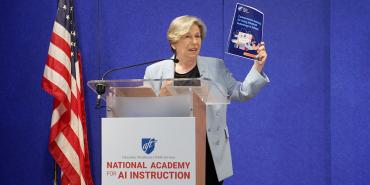In a sweeping move to leverage artificial intelligence as a tool for learning and to minimize its harms, the AFT has partnered with the United Federation of Teachers, Microsoft, OpenAI and Anthropic to launch a first-of-its-kind national AI academy for educators. The goal: equip teachers with the knowledge and training to harness AI responsibly, ethically and effectively in the classroom.
The National Academy for AI Instruction, unveiled during a press conference and panel discussion with representatives from all the participating partners at the United Federation of Teachers, will provide access to free AI training and curriculum for all 1.8 million members of the AFT, starting with K-12 educators. It will be based at a state-of-the-art bricks-and-mortar Manhattan facility designed to transform how AI is taught and integrated into classrooms across the United States. It will help address the gap in structured, accessible AI training and provide a national model for AI-integrated curriculum and teaching.
The academy marks an ambitious collaboration between labor and tech companies—a partnership driven not by corporate mandates but by the needs of working educators.
“Teachers must be in charge of education—not the tool, not the machine,” said AFT President Randi Weingarten. “We’re choosing the GPS system, not the driverless car, so that we can navigate it, we can harness it, we can use it for the good that AI is supposed to be. But we can also make sure we have the guardrails we need to protect the safety and security of kids.”
AI’s increasingly ubiquitous presence in all aspects of daily life, from answering basic questions to rapidly synthesizing vast amounts of information, reveals there was never a question whether AI would fundamentally transform our world—the question, Weingarten said, was “whether we would be chasing it or whether we would be trying to harness it. If educators, school staff and their unions aren’t involved in shaping this technology, then others, who may not share our values or priorities, will make those decisions for us.”
Teachers as co-creators, not passive recipients
For decades, educators have been subjected to top-down reforms that promised transformation but delivered more paperwork. This time, the AFT and its partners are putting teachers at the center of the process.
“The most important thing in education is what happens inside of that classroom,” said UFT President Michael Mulgrew. “This tool can truly be a great gift to the children of this country—but only if it’s driven by the people doing the work.”
Educators’ input is necessary to ensure AI meets the students’ needs, said Chris Lehane of OpenAI.
“How can we make sure that in the K-12 context, we’re equipping students with those skills that they’re going to need to be able to succeed in what we think of as the Intelligence Age? You can’t do that unless it’s actually given to the teachers to actually do that work.”
At the new AI Academy, teachers will not just learn to use AI—they will co-create tools, offer feedback to developers and help shape how the technology is implemented in classrooms across the country. Training will be made widely accessible through Share My Lesson, the AFT’s digital learning platform.
Equal access: Big tech, big responsibility
Executives from Microsoft and OpenAI spoke candidly about the stakes involved in ensuring that access to AI is not determined by tax bracket. Gerry Petrella from Microsoft emphasized that “access must be democratized,” with a focus on reaching low-income communities and students with special needs.
“We need to close the gap quickly,” he said.
Chris Lehane from OpenAI echoed the urgency: “We need to move fast so that a kid in Compton or rural Maine, which is where I’m from, has the same access to think, to learn, to create and to produce.”
Lehane compared the potential impact of AI, and the potential pitfalls of its implementation, to another technological innovation that transformed everyday life: electricity.
“What is the lesson from electricity?” he asked. “In the first 20-odd years of the 20th century, those who had financial resources were able to get access to electricity. Those who lived primarily in rural areas did not.”
AI implementation in schools does not have to reflect that, Lehane said. “We have the chance to get this right.”
The academy will also provide a testing ground for teaching and learning techniques, to develop best practices and understand what works.
“Education should be the one place where we all cheer when children succeed,” Mulgrew said. “But too often, it becomes political. That’s why we need irrefutable evidence that this brings real value to teachers and leads to better success for students.”
Creating common sense guardrails
In the absence of federal regulation, teachers are being asked to do more than adapt—they’re being asked to protect their students in an uncharted digital world.
“In the absence of federal guardrails, we become the ones who must ensure that this tool is used safely, wisely and ethically,” said Weingarten. “And we need the help of these big tech companies to help us do this work because they own so much of the coding and so much of the tool itself.”
Hope with eyes wide open
The project is ambitious: training millions of teachers, gathering insights from classrooms of every kind and creating a national model for responsible AI in education. And Weingarten acknowledges that many educators are skeptical, but then so is she.
“Skeptics ask the right questions. And in some ways, the skeptic is the most hopeful,” Weingarten concluded. “And our hope is that putting this tool in teachers’ hands—letting them unleash their passion and their skill—will make our kids’ lives better.”
[Melanie Boyer]
Resources
Watch the press conference and panel discussion on Facebook or YouTube.
Share My Lesson: AI Educator Brain
Share My Lesson: K-12 Teaching in the Era of AI and Social Media: Lesson Plans and Resources
Report: Commonsense Guardrails for Using Advanced Technology in Schools

